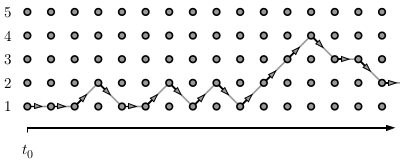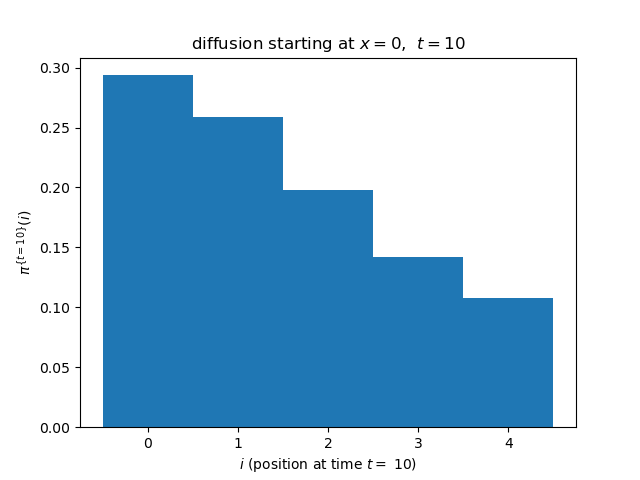Diffusion.py
From Werner KRAUTH
Contents |
Context
This page is part of my 2024 Beg Rohu Lectures on "The second Markov chain revolution" at the Summer School "Concepts and Methods of Statistical Physics" (3 - 15 June 2024).
We consider a particle diffusing on a path graph with five sites, always starting at position i = 0, at time t=0. Arrows go "down", "straight" and "up" with equal probability. In application of the Metropolis algorithm, an arrow that goes outside the range [0, N - 1] is rejected, that is, replaced by a straight arrow. The stationary distribution of this reversible Markov chain is uniform on the N sites, because the probability to move from site i to site j equals the probability to move from site j to site i.
Python program
import random
import matplotlib.pyplot as plt
N = 5
data = []
tmax = 10
for stat in range(100000):
pos = 0
for t in range(tmax):
pos = min(max(pos + random.choice([-1, 0, 1]), 0), N - 1)
data.append(pos)
plt.title('diffusion starting at $x=0$, $t = $' + str(tmax))
plt.hist(data, bins=N, range=(-0.5, N-0.5), density=True)
plt.savefig('diffusion.png')
plt.show()
NB: The line containing the "pos = min(max ... " statement may appear cryptic, but it simply performs the random walk from the position "pos" in "down", "straight" and "up" directions, with the necessary cropping at the boundaries that keeps the random walk safely within the range [0, N-1].
Output
Here is output of the above Python program. Although the stationary distribution is flat, as discussed above, the distribution pi^t, at finite times t is biased towards the initial configuration i(t=0) = 0. The below figure shows
The errors with respect to the flat distribution are finite at each finite time t.
Further Information
- Rather than to start at the 'bad' initial configuration i(t=0) = 0, one might be tempted to start it in the middle, but this contradicts the fact that, in real applications, one cannot usually choose a "good" initial configuration.
- One may also want to replace the 'bad' initial configuration by a random initial configuration i(t=0) = choice(0, ... N - 1). But this would mean that we do not have to do Markov-chain sampling at all, because a direct-sampling strategy is available.
All this was discussed in detail in the lectures, and gave rise to lively discussions.


